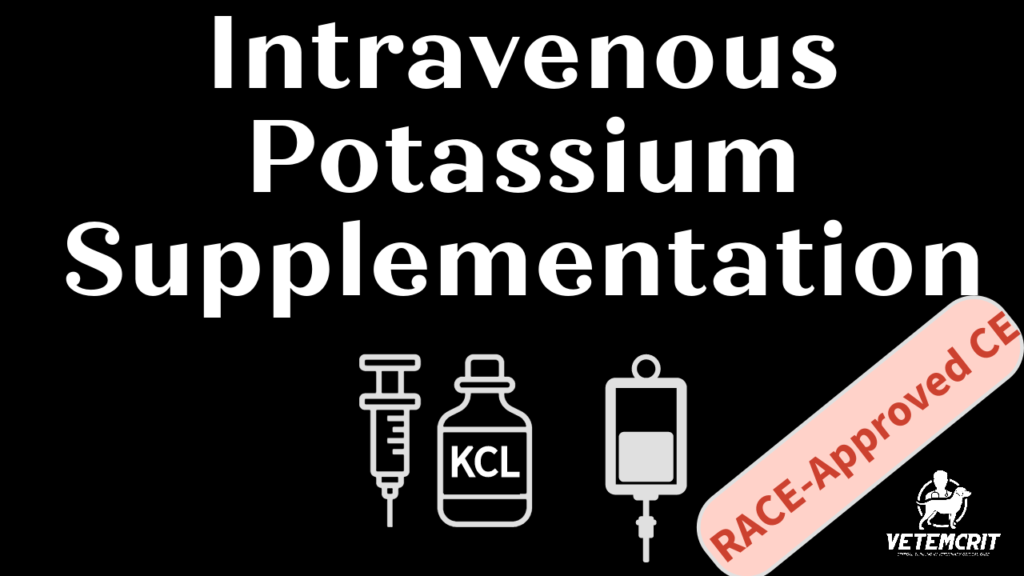Potassium functions as the primary cation inside cells. More than 95% of the total body potassium resides within the cells. Abnormal serum potassium levels may arise due to disturbances in potassium intake, imbalances in internal potassium distribution, or issues with external potassium excretion.
Changes in how potassium is distributed within cells, such as when ß-adrenergic stimulation (as seen in albuterol toxicosis) prompts the movement of potassium in the liver and muscle cells, are usually temporary. On the other hand, a prolonged lack of potassium intake or excessive potassium loss can lead to sustained hypokalemia.
Even though hypokalemia caused by the shift of potassium within cells is temporary, potassium supplementation may be necessary when hypokalemia is moderate to severe, especially if there are observable symptoms like arrhythmia and/or muscle weakness. However, the rate at which potassium is supplemented may need adjustment to prevent a condition called ‘rebound hyperkalemia,’ which can occur after the cause of the potassium shift is resolved.
For instance, as the effects of albuterol wear off, the excess potassium stored in cells (due to the earlier shift caused by albuterol and the initial potassium supplementation) moves back into the bloodstream, causing an increase in blood potassium levels.
The rebound hyperkalemia has been reported in veterinary medicine (Guida et al. JVECC 2023). A retrospective case series on albuterol exposure in dogs demonstrated hyperkalemia in 4 of 16 dogs that had potassium reevaluated within 12 hours of hospitalization (Meroni et al. JVECC 2021). Rebound hyperkalemia has also been reported in a 21-year-old woman receiving terbutaline, also a beta-adrenergic agonist, during preterm labor.

Because the concentration of potassium is tightly regulated in the bloodstream, rebound hyperkalemia requires both the movement of potassium within cells due to a drug or metabolic trigger and the redistribution of potassium from inside cells to the bloodstream as the initial trigger diminishes. In contrast, states of total body potassium depletion, like in diabetic ketoacidosis, chronic kidney disease, and hyperaldosteronism, would not be expected to lead to rebound hyperkalemia.
Ways to prevent rebound hyperkalemia:
- Consider more conservative potassium supplementation in animals with albuterol toxicity and other causes of transient transcellular potassium shifting.
- Discontinue KCL supplementation once serum [K+] >3.1
- Monitor serum [K+] for 12-24 hours after KCL supplementation was discontinued.
- As the duration of action of albuterol (when ingested) is 12 hours, it may be reasonable to correlate trends in potassium and plasma lactate concentration when determining supplementation strategies, as the mechanism that leads to hypokalemia and hyperlactatemia (type B) in albuterol toxicosis is similar. Hypokalemia occurs secondary to ß2 stimulation of the Na/K-ATPase pump, and hyperlactatemia occurs secondary to Na/K-ATPase-stimulated aerobic glycolysis associated with catecholamine stimulation through ß2 adrenergic receptors.
Proposed guidelines for the rate of KCL supplementation in cases of transient hypokalemia (i.e. suspected transcellular shift)
| Serum potassium, mEq/L | KCL supplementation, mEq/kg/hr | Serum [K+] recheck |
| >3.1 | DO NOT SUPPLEMENT | Every 8 hours |
| 2.9-3.1 | 0.05-0.1 mEq/kg/hr | Every 6 hours, stop supplementation once [K+]>3.1 |
| 2.7-2.9 | 0.1-0.2 mEq/kg/hr | Every 6 hours, stop supplementation once [K+]>3.1 |
| 2.4-2.6 | 0.2-0.25 mEq/kg/hr | Every 6 hours, stop supplementation once [K+]>3.1 |
| <2.4 + no clinical signs | 0.3-0.35 mEq/kg/hr | Every 4 hours, reduce rate when [K+]>2.5; stop supplementation once [K+]>3.1 |
| <2.4 + clinical signs (arrhythmia or muscle/respiratory weakness) | 0.35-0.4 mEq/kg/hr | Every 2 hours, reduce rate when [K+]>2.5; stop supplementation once [K+]>3.1 |
The Bottom Line
Managing hypokalemia, whether induced by transient shifts in potassium or prolonged depletion, requires a nuanced approach. While potassium supplementation may be necessary to address moderate to severe hypokalemia and associated symptoms, it’s crucial to be vigilant about the risk of rebound hyperkalemia, particularly in cases like albuterol toxicosis. This phenomenon, characterized by a sudden surge in blood potassium levels after the initial cause of potassium shift resolves, demands careful monitoring and adjustment of supplementation rates. Learning from reported cases, especially in veterinary medicine, sheds light on preventive measures and supplementation guidelines. By adopting conservative supplementation strategies and closely monitoring potassium levels post-supplementation, veterinarians can mitigate the risk of rebound hyperkalemia and ensure optimal potassium balance in their patients.
References
Guida SJ, Bazzle L. Rebound hyperkalemia in a dog with albuterol toxicosis after cessation of potassium supplementation. J Vet Emerg Crit Care. 2023; 33: 715–721. https://doi.org/10.1111/vec.13352
Kuczkowski KM, Benumof JL. Rebound hyperkalemia after cessation of intravenous tocolytic therapy with terbutaline in the treatment of preterm labor: anesthetic implications. J Clin Anesth. 2003 Aug;15(5):357-8. doi: 10.1016/s0952-8180(03)00028-x. PMID: 14507561.
Meroni ER, Khorzad R, Bracker K, Sinnott-Stutzman V. Retrospective evaluation of albuterol inhalant exposure in dogs: 36 cases (2007-2017). J Vet Emerg Crit Care (San Antonio). 2021 Jan;31(1):86-93. doi: 10.1111/vec.13012. Epub 2020 Oct 29. PMID: 33118712.


